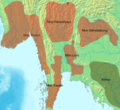Mon kingdoms facts for kids
The Mon kingdoms were powerful states built by the Mon people. They lived in areas that are now Myanmar and Thailand. These kingdoms included places like Dvaravati and Haripuñjaya in northern Thailand. Other important Mon kingdoms were Thaton, Hanthawaddy (from 1287 to 1539), and the Restored Hanthawaddy (from 1740 to 1757) in southern Myanmar.
Contents
Early Mon States
The first known kingdom linked to the Mon people was Dvaravati. This kingdom was very successful until about 1000 CE. At that time, its capital city was attacked by the Khmer Empire. Many people from Dvaravati moved west to what is now Lower Burma. There, they started new kingdoms. Another Mon-speaking state called Haripuñjaya also existed in northern Thailand until the late 1200s.
The Thaton Kingdom (9th Century?–1057?)
Some historians believe the Mon people set up small kingdoms or large city-states in Lower Burma around the 800s. The cities of Thaton and Pegu (Bago) are thought to have been founded in the 9th century. These states were important trading ports. They connected the Indian Ocean with mainland Southeast Asia.
According to older stories, the early Mon city-states were taken over by the Pagan Kingdom from the north in 1057. It is said that Thaton's writings and religious traditions helped shape the early Pagan civilization. Between 1050 and 1085, Mon artists and builders helped create many monuments in Pagan. These monuments are still amazing today, like the famous Angkor Wat. The Mon script is also believed to be the origin of the Burmese script.
However, some newer studies suggest that the Mon influence on Pagan might have been less than previously thought. They argue that Lower Burma might not have had a large, independent kingdom before Pagan expanded. Despite these debates, most experts agree that Pagan took control of Lower Burma in the 11th century. This led to more cultural exchange. It connected Pagan with India and Sri Lanka, which was a strong center for Theravada Buddhism.
The Hanthawaddy Kingdom (1287–1539, 1550–1552)
In 1287, the Pagan Empire fell apart because of Mongol invasions. All the smaller states that were part of it became independent. In Lower Burma, a leader named Wareru created a kingdom for the Mon people. It was called Ramannadesa. He brought together three Mon-speaking areas: Martaban (Mottama), Pegu (Bago), and the Irrawaddy delta. The first capital was Martaban, but it moved to Pegu in 1369.
For its first 100 years, the kingdom was not very strong. The kings had little power over the local rulers. Martaban even rebelled from 1363 to 1389. The kingdom became much stronger under King Razadarit. He united the three Mon regions firmly. He also successfully defended against the Burmese-speaking Kingdom of Ava from the north. This was during the Forty Years' War (1385–1424). The war ended in a tie, but it was a win for Hanthawaddy. Ava finally gave up its dream of bringing back the Pagan Empire.
After this war, Hanthawaddy entered its "golden age." Meanwhile, its rival, Ava, slowly became weaker. From the 1420s to the 1530s, Hanthawaddy was the richest and most powerful kingdom among all the states after Pagan. Great kings like Binnya Ran I, Shin Sawbu, Dhammazedi, and Binnya Ran II ruled during this time. The kingdom became rich from trade with other countries. Its merchants traded across the Indian Ocean, bringing in gold, silver, silk, and spices. Hanthawaddy also became a famous center for Theravada Buddhism. It had strong connections with Ceylon (now Sri Lanka). It also encouraged religious changes that later spread throughout the country.
The end of this powerful kingdom came suddenly. Because King Takayutpi was not experienced, a smaller kingdom from the north, the Kingdom of Toungoo, captured it in 1539. This was led by King Tabinshwehti and his general, Bayinnaung. Toungoo took the Irrawaddy delta and Pegu in 1538–1539, and Martaban in 1541. The kingdom was briefly brought back to life in 1550 after Tabinshwehti was killed. But Bayinnaung quickly defeated the rebellion in 1552.
The Restored Hanthawaddy Kingdom (1740–1757)
Even though Toungoo kings ruled Lower Burma until the mid-1700s, the Mon people fondly remembered Hanthawaddy's golden age. In 1740, they rebelled against a weak Toungoo Dynasty. They successfully brought back the Hanthawaddy Kingdom. With help from the French, this new kingdom quickly grew strong in Lower Burma. It then pushed northward. On March 23, 1752, its forces captured Ava. This ended the 266-year-old Toungoo dynasty.
A new dynasty called Konbaung rose in Upper Burma. It was led by King Alaungpaya. This new power challenged the southern forces. By January 1754, Konbaung had taken over all of Upper Burma. Hanthawaddy's second invasion of Upper Burma failed in May 1754. After this, the Hanthawaddy leaders made bad decisions. They killed the Toungoo royal family and treated ethnic Burmans in the south badly. These actions only made Alaungpaya stronger. In 1755, Alaungpaya invaded Lower Burma. Konbaung forces captured the Irrawaddy delta in May 1755. They took the French-defended port of Thanlyin in July 1756. Finally, they captured the capital Pegu in May 1757.
The fall of the Restored Hanthawaddy Kingdom marked the end of the Mon people's long control over Lower Burma. The Konbaung armies punished the Mon people. Thousands of Mons had to escape to Siam (now Thailand). By the early 1800s, many Mons had mixed with other groups or married outside their community. Also, many Burman families moved from the north. This caused the Mon population to become a small minority.
Images for kids


